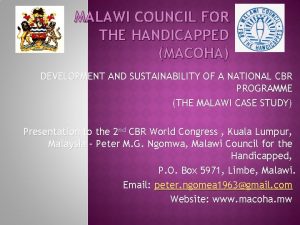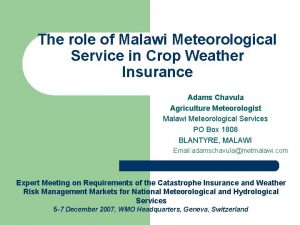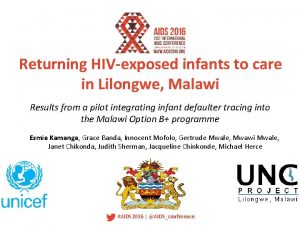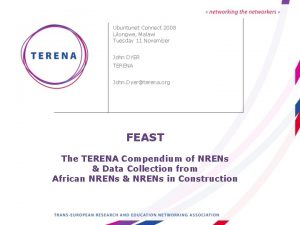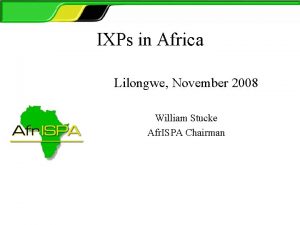Africa launch Lilongwe Malawi 13 March 2019 Prof




















- Slides: 20

Africa launch Lilongwe, Malawi, 13 March 2019 Prof Gerry Stimson Emeritus Professor Imperial College London Honorary Professor London School of Hygiene and Tropical Medicine Director Knowledge-Action-Change The conception, design, analysis and writing of No Fire, No Smoke: The Global State of Tobacco Harm Reduction 2018 was undertaken by Knowledge-Action-Change and supported solely by a grant from the Foundation for a Smoke-Free World. The Foundation played no part in determining the content, analysis, or conclusions in the report and provided input only at the initial concept stage.

Why the GSTHR report? Major changes in how nicotine is consumed in many countries – e-cigarettes, snus, heated tobacco products (‘heat not burn’) A shift away from combustible products eg cigarettes Implications for tobacco producers, tobacco companies, consumers Potential to reduce risk of disease and premature death. GSTHR maps: • Who is using safer nicotine products; • Government regulations • The public health potential of tobacco harm reduction.

The global smoking problem Half of all those who smoke will die prematurely from smoking-related diseases Over six million people die from a smokingrelated disease every year 70% of deaths are in low and middle-income countries More people die from smoking cigarettes than from malaria, HIV and TB combined WHO estimates that by the end of the century one billion people will have suffered a smokingrelated disease It is the poor who suffer most from smoking and the poorest countries are least able to enforce effective tobacco controls

Smoking in Malawi It’s about men! • 19% of men smoke daily • 3% of women smoke daily • Over 1 million daily smokers • 5, 179 deaths attributable to smoking in 2016 Compare: • HIV/AIDS: 24, 000 deaths 2016 * • Malaria: 7, 100 deaths pa ** • TB: 5, 500 deaths pa *** * UNAIDS http: //www. unaids. org/en/regionscountries/malawi ** GFATM https: //www. theglobalfund. org/media/7996/mwih_result_profile_en. pdf ****https: //extranet. who. int/sree/Reports? op=Replet&name=%2 FWHO_ HQ_Reports%2 FG 2%2 FPROD%2 FEXT%2 FTBCountry. Profile&ISO 2=MW&LA N=EN&outtype=html

Smoking in Malawi imports cigarettes Collins Chansa, Takondwa Mwase, Thulani Clement Matsebula, Priscilla Kandoole, Paul Revill, John Bosco Makumba & Magnus Lindelow (2018): Fresh Money for Health? The (False? ) Promise of “Innovative Financing” for Health in Malawi, Health Systems & Reform

Malawi health investments • Major investments in HIV, Malaria and TB prevention and treatment: $1. 3 billion cumulative from 2003, GFATM * • Major success in driving down transmission and providing treatment • But minimal action against smoking ** • No restrictions on smoking in public places, advertising, or promotion; no minimum age to purchase tobacco; no health warnings on packs; no laws requiring a minimum tobacco excise tax rate*** * https: //www. theglobalfund. org/en/portfolio/country/? loc=MWI&k=b 2 d 78 cbb-a 8 d 0 -45 e 2 -a 78 c-9 e 53 b 907 c 4 a 3 ** https: //www. who. int/tobacco/surveillance/policy/country_profile/mwi. pdf *** https: //www. tobaccocontrollaws. org/legislation/country/malawi/summary

Smoking in many African countries is predicted to rise The steep smoking declines in richer countries are slowing while in poorer countries smoking is set to rise

The problem is combustion The tobacco cigarette is the most dangerous way of consuming nicotine Images from BBC News and Malawi Environmental Health Association

People smoke for nicotine but die from the tar Prof Mike Russell 1976 “Smokers cannot easily stop smoking because they are addicted to nicotine…. People smoke for nicotine but they die from the tar. ” 1976 BMJ 1: 1430 -1433 More than 7, 000 chemicals in tobacco smoke At least 250 are known to be harmful At least 69 can cause cancer. * Nicotine itself does not cause cancer. ** * US NIH https: //www. cancer. gov/about-cancer/causesprevention/risk/tobacco/cessation-fact-sheet ** "Does nicotine cause cancer? ". European Code Against Cancer. World Health Organization – International Agency for Research on Cancer. 9

Why don’t people just stop smoking? • Lack of awareness of risks • Many people like smoking and like nicotine • Some people give up smoking, on their own or with medicinal products – but there is a high failure rate • Is ‘quit or die’ the only option for those who cannot give up smoking?

Providing safer ways to deliver nicotine enables people to continue using it but to avoid the health risks of smoking UK Royal College of Physicians 2007: • Harm reduction in smoking can be achieved by providing smokers with safer sources of nicotine that are acceptable and effective cigarette substitutes. ’ p 241 2007

Safer Nicotine Products (SNP) deliver nicotine lower risk as compared to combusted tobacco products – there is ‘No Fire, No Smoke’

E-cigarettes Public Health England: ‘Our new review reinforces the finding that vaping is a fraction of the risk of smoking, at least 95% less harmful, and of negligible risk to bystanders. ’ Snus Not associated with premature mortality, diabetes, pancreatic and oral cancers, heart disease or strokes.

‘We should be encouraging smokers to switch’ Public Health England ‘There is an opportunity here to further reduce the harms caused by tobacco by encouraging more smokers to try vaping and for ‘dual-users’ to switch completely. ’ Public Health England: Vaping in England: an evidence update February 2019 https: //www. gov. uk/government/publications/vaping-in-england-an-evidence-update-february-2019/vaping-in-england-evidence-update-summary-february-2019 https: //publichealthmatters. blog. gov. uk/2019/02/27/e-cigarette-evidence-update-patterns-and-use-in-adults-and-young-people/

Strong links between rise in safer nicotine products and decline in smoking • Japan – since the introduction of heat-not-burn products, a 27% fall in tobacco sales in two years • Norway – rise in the use of snus by young women has seen daily smoking drop to 1% • Sweden – snus has displaced smoking, Sweden has the lowest level of smoking in Europe and the lowest smoking-related deaths • UK – rapid drop in smoking since e-cigarettes were introduced

Rapid drop in smoking in Norway; rise of snus

The GSTHR report is founded on the principle of harm reduction. A core public health strategy – as set out in the Ottawa Charter on Health Promotion – enabling people to make healthier choices and to lead healthier lives • International treaties on the right to health eg Harm reduction is one of the three core elements of tobacco control, as defined in the Framework Convention on Tobacco Control.

GSTHR assessment of tobacco harm reduction • • • Safer nicotine products can replace smoking; it can happen quickly This happened mainly without government initiative An end to smoking may be achievable but not an end to nicotine use These trend will impact on tobacco production These products could lead to a global revolution in public health

What can governments do? • Tobacco harm reduction is of zero cost to governments • Don’t panic and ban – as some countries have! • Raise awareness amongst health professionals that for smokers it is safer to use a non-combustible product – it’s the smoke that kills • Encourage (or do not hinder) national production of safer nicotine products

Thank you!
 Mij fm news
Mij fm news Crossroads hotel lilongwe
Crossroads hotel lilongwe Anthem of poland
Anthem of poland Grihalakshmi magazine march 2019
Grihalakshmi magazine march 2019 Kaggle march madness
Kaggle march madness Mary's meals malawi
Mary's meals malawi Welke taal spreken ze in malawi
Welke taal spreken ze in malawi Macoha
Macoha Macoha malawi
Macoha malawi Malawi'''s pizza delivery
Malawi'''s pizza delivery Meteorological services for insurance
Meteorological services for insurance Lighthouse malawi
Lighthouse malawi Cham malawi
Cham malawi Saips malawi
Saips malawi Jwst launch
Jwst launch Yammer post examples
Yammer post examples Ardu recovery center
Ardu recovery center Kendra legge
Kendra legge First nations launch
First nations launch Narrow product launch windows
Narrow product launch windows Jeff walker product launch formula summary
Jeff walker product launch formula summary







